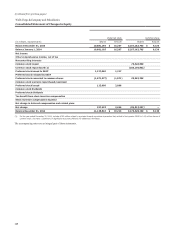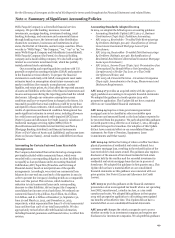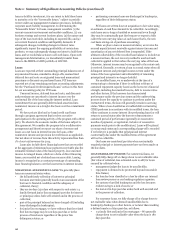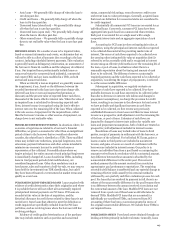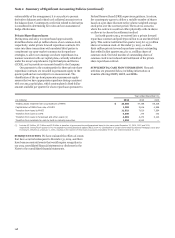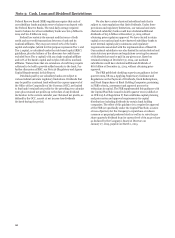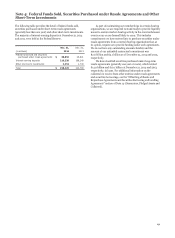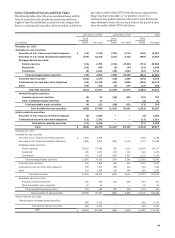Wells Fargo 2014 Annual Report Download - page 148
Download and view the complete annual report
Please find page 148 of the 2014 Wells Fargo annual report below. You can navigate through the pages in the report by either clicking on the pages listed below, or by using the keyword search tool below to find specific information within the annual report.Note 1: Summary of Significant Accounting Policies (continued)
benefit payments for our plans. Such portfolios are derived from
a broad-based universe of high quality corporate bonds as of the
measurement date.
Our determination of the reasonableness of our expected
long-term rate of return on plan assets is highly quantitative by
nature. We evaluate the current asset allocations and expected
returns under two sets of conditions: projected returns using
several forward-looking capital market assumptions, and
historical returns for the main asset classes dating back to 1970
or the earliest period for which historical data was readily
available for the asset classes included. Using long term
historical data allows us to capture multiple economic
environments, which we believe is relevant when using historical
returns. We place greater emphasis on the forward-looking
return and risk assumptions than on historical results. We use
the resulting projections to derive a base line expected rate of
return and risk level for the Cash Balance Plan’s prescribed asset
mix. We evaluate the portfolio based on: (1) the established
target asset allocations over short term (one-year) and longer
term (ten-year) investment horizons, and (2) the range of
potential outcomes over these horizons within specific standard
deviations. We perform the above analyses to assess the
reasonableness of our expected long-term rate of return on plan
assets. We consider the expected rate of return to be a long-term
average view of expected returns. The use of an expected long
term rate of return on plan assets may cause us to recognize
pension income returns that are greater or less than the actual
returns of plan assets in any given year. Differences between
expected and actual returns in each year, if any, are included in
our net actuarial gain or loss amount, which is recognized in
OCI. We generally amortize net actuarial gain or loss in excess of
a 5% corridor from accumulated OCI into net periodic pension
cost over the estimated average remaining participation period,
which at December 31, 2014, is 21 years. See Note 20 (Employee
Benefits and Other Expenses) for additional information on our
pension accounting.
Income Taxes
We file consolidated and separate company federal income tax
returns, foreign tax returns and various combined and separate
company state tax returns.
We evaluate two components of income tax expense:
current and deferred. Current income tax expense represents our
estimated taxes to be paid or refunded for the current period and
includes income tax expense related to our uncertain tax
positions. We determine deferred income taxes using the
balance sheet method. Under this method, the net deferred tax
asset or liability is based on the tax effects of the differences
between the book and tax bases of assets and liabilities, and
recognizes enacted changes in tax rates and laws in the period in
which they occur. Deferred income tax expense results from
changes in deferred tax assets and liabilities between periods.
Deferred tax assets are recognized subject to management's
judgment that realization is “more likely than not.” Uncertain tax
positions that meet the more likely than not recognition
threshold are measured to determine the amount of benefit to
recognize. An uncertain tax position is measured at the largest
amount of benefit that management believes has a greater than
50% likelihood of realization upon settlement. Tax benefits not
meeting our realization criteria represent unrecognized tax
benefits. Foreign taxes paid are generally applied as credits to
reduce federal income taxes payable. We account for interest and
penalties as a component of income tax expense.
Stock-Based Compensation
We have stock-based employee compensation plans as more
fully discussed in Note 19 (Common Stock and Stock Plan). Our
Long-Term Incentive Compensation Plan provides for awards of
incentive and nonqualified stock options, stock appreciation
rights, restricted shares, restricted share rights (RSRs),
performance share awards (PSAs) and stock awards without
restrictions. For most awards, we measure the cost of employee
services received in exchange for an award of equity
instruments, such as stock options, RSRs or PSAs, based on the
fair value of the award on the grant date. The cost is normally
recognized in our income statement over the vesting period of
the award; awards with graded vesting are expensed on a
straight line method. Awards that continue to vest after
retirement are expensed over the shorter of the period of time
between the grant date and the final vesting period or between
the grant date and when a team member becomes retirement
eligible; awards to team members who are retirement eligible at
the grant date are subject to immediate expensing upon grant.
Beginning in 2013, certain RSRs and all PSAs granted
include discretionary performance based vesting conditions and
are subject to variable accounting. For these awards, the
associated compensation expense fluctuates with changes in our
stock price. For PSAs, compensation expense also fluctuates
based on the estimated outcome of meeting the performance
conditions.
Earnings Per Common Share
We compute earnings per common share by dividing net income
(after deducting dividends on preferred stock) by the average
number of common shares outstanding during the year. We
compute diluted earnings per common share by dividing net
income (after deducting dividends and related accretion on
preferred stock) by the average number of common shares
outstanding during the year, plus the effect of common stock
equivalents (for example, stock options, restricted share rights,
convertible debentures and warrants) that are dilutive.
Fair Value of Financial Instruments
We use fair value measurements in our fair value disclosures and
to record certain assets and liabilities at fair value on a recurring
basis, such as trading assets, or on a nonrecurring basis such as
measuring impairment on assets carried at amortized cost.
DETERMINATION OF FAIR VALUE We base our fair values on
the price that would be received to sell an asset or paid to
transfer a liability in an orderly transaction between market
participants at the measurement date. These fair value
measurements are based on exit prices and determined by
maximizing the use of observable inputs. However, for certain
instruments we must utilize unobservable inputs in determining
fair value due to the lack of observable inputs in the market,
which requires greater judgment in measuring fair value.
In instances where there is limited or no observable market
data, fair value measurements for assets and liabilities are based
primarily upon our own estimates or combination of our own
estimates and third-party vendor or broker pricing, and the
measurements are often calculated based on current pricing for
products we offer or issue, the economic and competitive
environment, the characteristics of the asset or liability and
other such factors. As with any valuation technique used to
estimate fair value, changes in underlying assumptions used,
including discount rates and estimates of future cash flows,
could significantly affect the results of current or future values.
146


